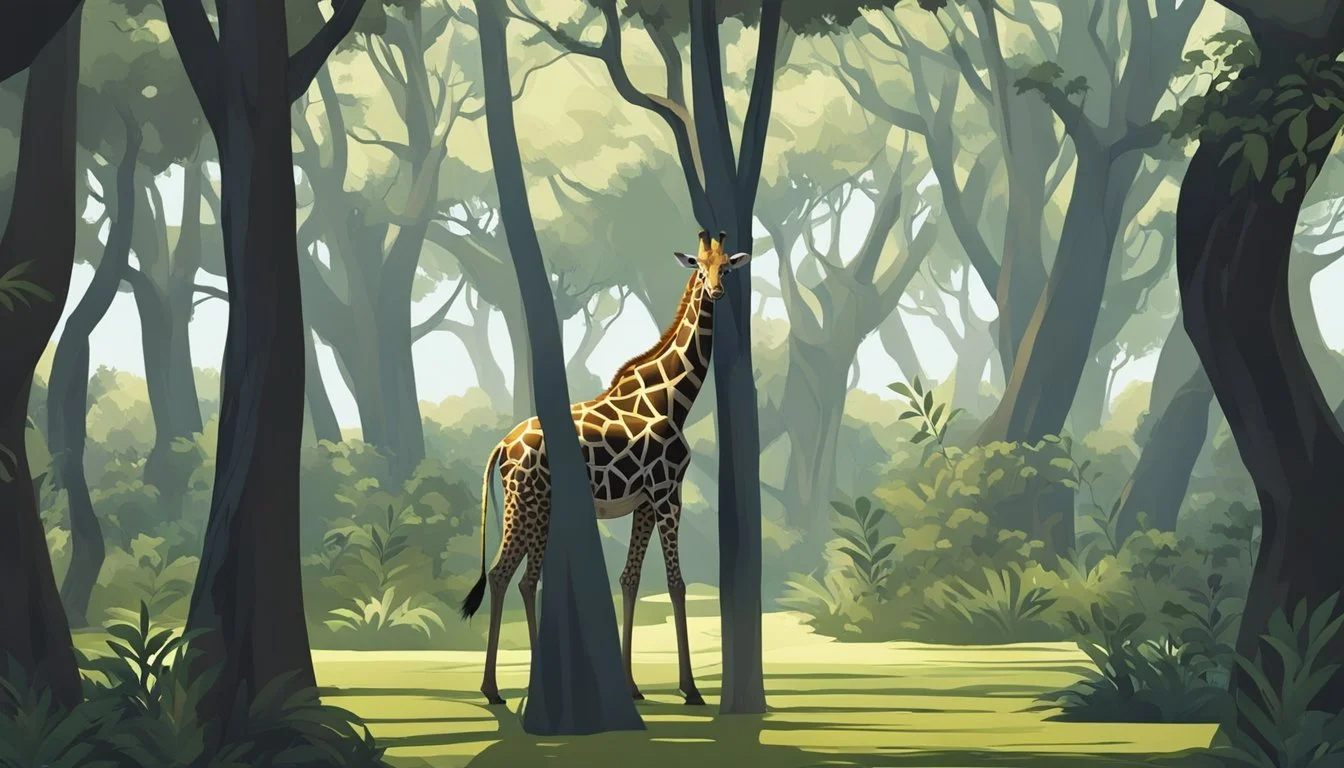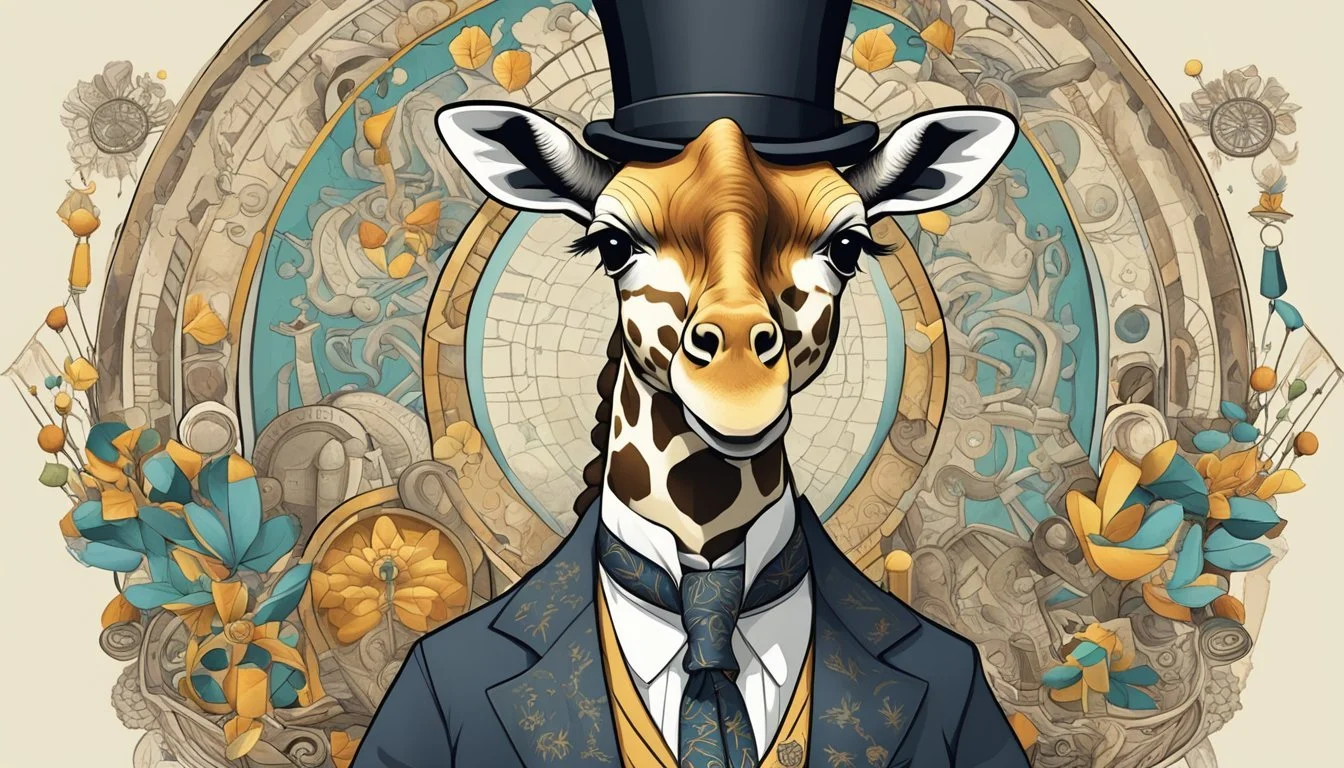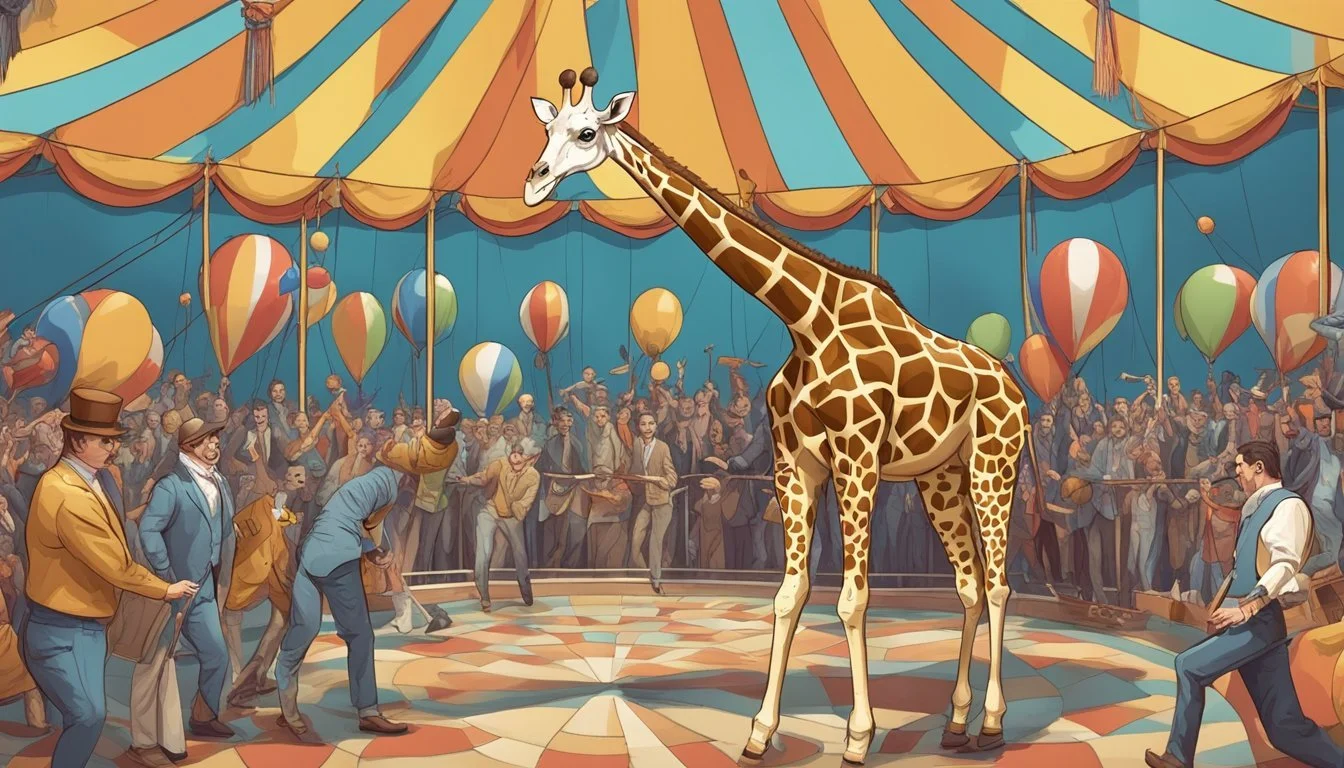Examining the Fictional Psychopathic Giraffe Character
Psychopath Giraffe is a unique and memorable character from the animated series "Pig Goat Banana Cricket." This tall, spotted antagonist stands out for his criminal tendencies and mental health struggles. Psychopath Giraffe suffers from psychosis and schizophrenia, which drive his erratic and often dangerous behavior in the show.
The character adds an element of unpredictability and dark humor to the series, contrasting with the more lighthearted antics of the main characters. His inclusion highlights the show's willingness to tackle mature themes within its absurdist framework.
Psychopath Giraffe's presence in "Pig Goat Banana Cricket" demonstrates the series' commitment to diverse and unconventional characters. His recurring appearances contribute to the show's interwoven storylines and offbeat charm, making him a notable figure in the animated landscape.
Understanding Psychopath Giraffe
Psychopath Giraffe is a distinctive villain character known for his erratic behavior and criminal tendencies. His unique blend of mental instability and giraffe physiology creates an intriguing antagonist.
Characteristics and Psychology
Psychopath Giraffe exhibits several notable traits that define his character. He has yellow fur with black spots, wears denim jeans, a black tank top with a skull, and black boots. This appearance combines typical giraffe features with a rebellious aesthetic.
Mentally, Psychopath Giraffe suffers from various disorders that drive his criminal actions. His psychological issues manifest in impulsive behavior and a disregard for laws and social norms. These traits align with common characteristics of psychopathy, including lack of empathy and poor behavioral control.
His tall stature, inherent to giraffes, symbolically represents his desire to stand out and achieve notoriety through his villainous acts.
Villain Role and Depiction
As a villain in the animated series, Psychopath Giraffe serves as an antagonist who creates conflict and challenges for the main characters. His criminal activities, such as stealing the presidential pickle, demonstrate his disruptive influence on society.
The juxtaposition of his giraffe nature with psychopathic tendencies creates a unique and memorable villain. This contrast likely adds humor and absurdity to his depiction, making him stand out among other animated antagonists.
Psychopath Giraffe's anger issues likely play a significant role in his villainous actions. His outbursts and aggressive behavior contribute to the chaos he creates in the show's plot.
The World of 'Pig Goat Banana Cricket'
'Pig Goat Banana Cricket' is an animated series that brings together four unlikely friends in a world of absurd adventures. The show's unique premise and creative approach to humor set it apart in the realm of children's animation.
Show Premise and Main Characters
'Pig Goat Banana Cricket' follows the lives of four roommates in Boopelite City. Pig is naive and fun-loving, Goat is a creative dreamer, Banana is self-centered, and Cricket is an eccentric inventor. Each episode typically features interconnected stories involving these characters.
The show aired on Nickelodeon for two seasons, starting in 2015. Its surreal humor and distinct animation style drew inspiration from underground comics. Psychopath Giraffe, voiced by Justin Roiland, is a recurring character known for his intense personality.
Creativity and Humor
The series is celebrated for its off-beat humor and imaginative storylines. Episodes often involve outlandish scenarios, such as "DJ Wheelbarrow Full of Nachos" and "The Mud Munchkins Must be Crazy."
The show's creators, Johnny Ryan and Dave Cooper, infused 'Pig Goat Banana Cricket' with a unique visual style. This aesthetic, combined with clever writing, appealed to both children and adults. The series gained a dedicated fandom who appreciated its quirky characters and bizarre plots.
'Pig Goat Banana Cricket' stands out for its willingness to embrace the strange and unexpected. This approach to storytelling allowed for a wide range of creative possibilities within its animated world.
Key Characters and Their Significance
The psychopath giraffe story features a diverse cast of characters that drive the narrative forward. These individuals play crucial roles in shaping the plot and developing the main protagonist, Banana.
Banana's Family Dynamic
Banana, the central character, comes from a complex family background. His father, a stern and traditional giraffe, often clashes with Banana's unconventional behavior. Banana's mother, in contrast, shows a more nurturing side, attempting to bridge the gap between father and son.
Banana's brothers add another layer to the family dynamic. The older brother serves as a role model, while the younger one often becomes an unwitting accomplice in Banana's schemes. This sibling rivalry and camaraderie create tension and humor throughout the story.
The family's interactions highlight themes of acceptance, rebellion, and the struggle to find one's place within societal norms.
Allies and Antagonists
Bill, Banana's best friend, stands out as a loyal companion. Despite his initial reluctance, Bill often gets dragged into Banana's misadventures. Their friendship provides comic relief and emotional depth to the narrative.
Brainy Jane, a highly intelligent giraffe, serves as both an ally and a foil to Banana. Her logical approach often clashes with Banana's impulsive nature, creating interesting dynamics and plot twists.
Miss Cutesy Meow Meows, a seemingly innocent cat, emerges as a surprising antagonist. Her sweet exterior masks a cunning mind, frequently putting her at odds with Banana's plans.
The story's villains, a group of poachers, represent the main external threat. Their presence adds tension and raises the stakes for Banana and his friends.
Recurring Characters and Cameos
The psychopath giraffe story features several recurring characters that enrich the narrative landscape. The local zookeeper appears regularly, alternating between an obstacle and an unwitting helper in Banana's schemes.
A group of mischievous monkeys frequently causes chaos, sometimes aiding Banana and other times hindering his plans. Their unpredictable nature adds an element of surprise to many scenes.
Celebrity cameos also make appearances throughout the story. These unexpected guests, often playing exaggerated versions of themselves, provide humorous interludes and occasionally influence the plot in surprising ways.
Cultural and Societal References
The concept of a "psychopath giraffe" has seeped into various aspects of popular culture, from historical allusions to modern political satire. This unusual pairing has been used to explore themes of power, morality, and societal norms.
Historical Figures and Influences
Thomas Jefferson, known for his fascination with natural history, once wrote a letter describing a "most peculiar giraffe" he encountered during his travels. This account, while likely embellished, sparked discussions about animal behavior and intelligence. Alexander Hamilton, in contrast, used the image of a "deceptive long-necked beast" as a metaphor for political opponents in his writings.
The idea of a cunning, manipulative giraffe gained traction in 19th-century literature. Authors drew parallels between the animal's height and perceived aloofness to criticize aristocratic detachment.
Political Satire in the Series
Modern political satire has embraced the "psychopath giraffe" trope with gusto. The popular animated series "Zoopolis" features a character called the "President of the Planet" - a giraffe known for his charismatic yet ruthless leadership style.
This character often clashes with his rival, the "Presidential Pickle," in storylines that mirror real-world political debates. The giraffe's ability to "look down" on others serves as a visual metaphor for perceived elitism in politics.
The show's creators use these animal personas to tackle complex issues like power abuse and media manipulation in a format accessible to a wide audience.
Anthropomorphism in Animation
Anthropomorphism in animation brings non-human characters to life with human traits and behaviors. This technique allows creators to explore complex themes through relatable yet fantastical beings.
Concept and Execution in the Show
"Pig Goat Banana Cricket" exemplifies anthropomorphism in modern animation. The show features four distinctly different characters - a pig, goat, banana, and cricket - each with unique personalities and human-like qualities.
The pig character displays intelligence and wit, often acting as the voice of reason. The goat embodies creativity and enthusiasm, frequently bursting into song. The banana, despite its inanimate nature, exhibits a laid-back attitude and serves as a comedic foil. The cricket demonstrates inventiveness and scientific curiosity.
By imbuing these diverse creatures with human traits, the show creates a surreal yet relatable world. This approach allows for exploration of friendship dynamics and personal growth in an engaging, visual format. The anthropomorphic characters serve as vehicles for storytelling, enabling the show to address complex topics in an accessible manner.
Contribution to Entertainment
Psychopath Giraffe has become a notable character in animated television, adding dark humor and unpredictability to the show Pig Goat Banana Cricket. His presence has sparked discussions about mental health representation in children's media.
Popularity and Ratings
Psychopath Giraffe's appearances on Pig Goat Banana Cricket helped boost the show's ratings among Nickelodeon's target audience. His erratic behavior and criminal tendencies provided a stark contrast to the main characters, attracting viewers who enjoyed edgier content.
The character's popularity led to increased screen time and merchandise featuring his image. Clips of Psychopath Giraffe's antics became viral on social media platforms, expanding the show's reach beyond its traditional viewer base.
Critique and Appreciation
Critics praised the creators Dave Cooper and Johnny Ryan for their bold approach in introducing a character with mental health issues to a children's show. Psychopath Giraffe's portrayal sparked debates about responsible representation of mental illness in media.
Some mental health advocates expressed concerns about the character reinforcing negative stereotypes. Others appreciated the attempt to address complex topics in an accessible format. Animation experts commended Nick Cross's visual design of Psychopath Giraffe, which effectively conveyed the character's unstable nature through expressive features and erratic movements.
The character's impact extended beyond the show, inspiring fan art and cosplay at conventions. Psychopath Giraffe became a talking point in discussions about pushing boundaries in children's entertainment.
Creative Team and Production
The creative minds behind "Psychopath Giraffe" brought unique vision and expertise to the series. Their collaborative efforts shaped the show's distinct style and memorable characters.
The Minds Behind the Series
Dave Cooper and Johnny Ryan served as the primary creative forces for the show. Cooper, known for his surreal art style, brought visual flair to the character designs. Ryan, a comic book artist, contributed his offbeat humor and storytelling sensibilities.
Nick Cross joined the team as animation director, bringing his experience from other animated projects. The trio's combined talents resulted in the show's quirky aesthetic and irreverent tone.
Animation and Visual Style
The series utilized a bold, colorful animation style that complemented its eccentric characters. Hand-drawn elements were combined with digital techniques to create a visually striking world.
Character designs, including Psychopath Giraffe, featured exaggerated proportions and expressive features. Backgrounds often incorporated surreal elements, enhancing the show's offbeat atmosphere.
The animation team paid special attention to fluid movement and dynamic action sequences. This approach brought energy to the characters' antics and heightened the comedic timing of gags.
Lexicon and Dialogue
The language and speech patterns of psychopaths exhibit distinct characteristics. Their lexicon and dialogue reveal key insights into their thought processes and behaviors.
Catchphrases and Linguistic Impact
Psychopaths often employ manipulative language techniques to charm and deceive others. They may use catchphrases or repetitive linguistic patterns to establish rapport and create a false sense of familiarity. Their speech tends to be grandiose and self-centered, frequently using "I" statements.
Psychopaths' dialogue can be superficially charming but lacks emotional depth. They may struggle to express genuine empathy or remorse in their language. Their vocabulary often includes words related to power, control, and dominance.
In verbal exchanges, psychopaths might use rapid speech or change topics abruptly to maintain control of conversations. They may also employ vague language or non-sequiturs to avoid direct questions or accountability.
Researchers have noted that psychopaths' language contains more causative words (because, since) and fewer emotional terms compared to non-psychopathic individuals. This linguistic pattern reflects their tendency to rationalize behaviors and detach from emotional experiences.
Merchandise and Fandom
Psychopath Giraffe's popularity has led to various merchandise offerings and a dedicated fanbase. Fans engage in creative activities to celebrate the character, while official products allow them to show their appreciation.
Marketing and Merchandising Strategies
Psychopath Giraffe merchandise includes t-shirts, hats, and posters featuring the character's distinctive appearance. Plush toys of the yellow-furred, black-spotted giraffe wearing his iconic black tank top and jeans are particularly popular among collectors.
Limited edition action figures depict Psychopath Giraffe in various poses, sometimes including accessories like his guitar. These items are sold through official channels and at conventions, creating a buzz among fans.
Collaborations with artists have resulted in unique Psychopath Giraffe-themed artwork, available as prints or on phone cases. Some merchandise incorporates the character's memorable quotes, appealing to die-hard fans of the show.
Fandom Culture and Fan Activities
Psychopath Giraffe has inspired a vibrant fandom community. Fans create and share fanart on social media platforms, showcasing their interpretations of the character in various styles and scenarios.
Cosplay is popular at conventions, with fans donning yellow bodysuits, black spots, and the character's signature outfit. Some cosplayers go the extra mile by crafting props like Psychopath Giraffe's guitar.
Fan fiction writers explore alternative storylines or expand on the character's backstory. Online forums and fan sites serve as hubs for discussions about Psychopath Giraffe's appearances and memorable moments in the show.
Fan-made music videos featuring Psychopath Giraffe often circulate online, with some creators composing original songs inspired by the character. These videos showcase the fandom's creativity and dedication to the quirky giraffe.
Exploring the Show's Themes
"Pig Goat Banana Cricket" explores themes of friendship, identity, and comedic absurdity through its eclectic cast of characters. The show's writing balances humor with underlying messages about relationships and self-expression.
Friendship and Relationships
The four main characters live together as roommates, showcasing diverse personalities and interests. Their interactions highlight the importance of accepting differences in friendships. Pig's levelheadedness often contrasts with Banana's impulsivity, while Goat's artistic nature complements Cricket's scientific mindset.
The show depicts how friends can support each other through challenges, even when their approaches differ. Episodes frequently center on the characters helping one another achieve goals or overcome obstacles. This dynamic reinforces the value of loyalty and cooperation in relationships.
Secondary characters like Psychopath Giraffe add complexity to the social landscape. His unpredictable behavior tests the main characters' patience and problem-solving skills, reflecting real-world friendship challenges.
Comedic Elements and Writing
The show's humor relies heavily on surreal situations and unexpected twists. Writers blend slapstick comedy with clever wordplay to appeal to a wide audience. Visual gags often complement verbal jokes, creating layered comedic moments.
Character-driven humor forms the backbone of many episodes. Each protagonist's unique quirks lead to comical misunderstandings and conflicts. Psychopath Giraffe's erratic actions, for instance, frequently serve as a catalyst for absurd plot developments.
The writing incorporates pop culture references and parodies, adding depth for older viewers. These elements are balanced with more straightforward humor to maintain accessibility for younger audiences. The show's ability to juggle different comedic styles contributes to its broad appeal and replay value.










